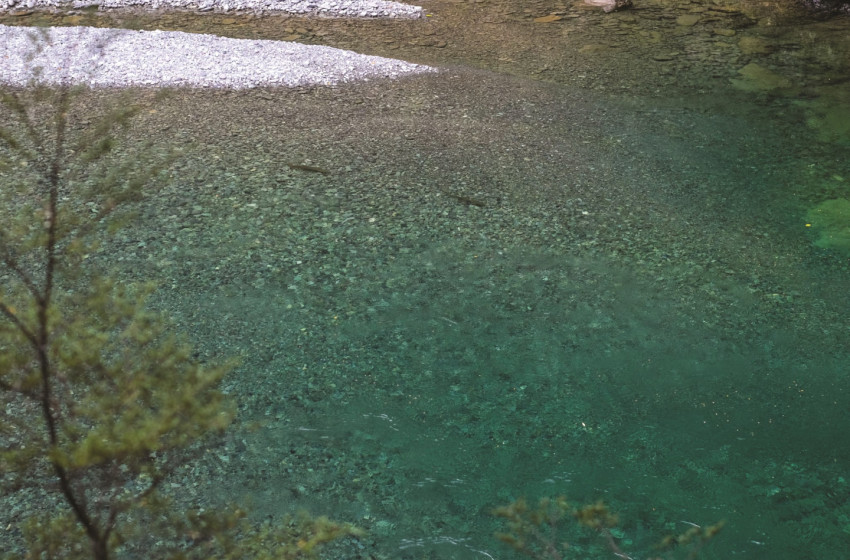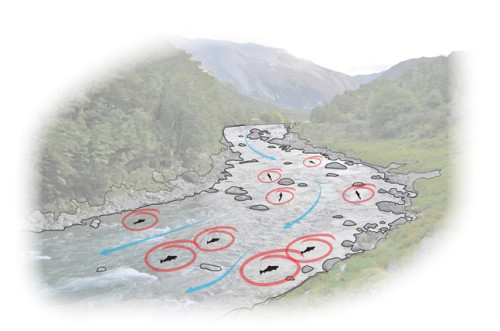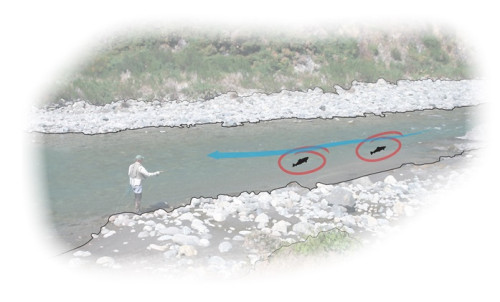Reading Water, Finding Fish
- 25/09/2024
- Roslyn Simmonds

By Hamish Carnachan
There's an old saying in the entertainment business: 'Never work with kids or animals.' The rationale being that both are inherently unpredictable and, at times, entirely uncooperative.
Whilst filming an instructional video clip for Fish & Game's You Tube channel some years back, that adage hit home. Way back on some Canterbury high country water our intention was to illustrate the types of structure typically encountered on a river and pinpoint where anglers could most likely expect to find fish holding.
The stretch of water we set up on was perfect. Within 100m we essentially had all the different features we were hoping to identify – runs, riffles, drop-offs, slack flow and pocket water. Being a wilderness fishery, there was a realisation that fish density wasn’t likely to be high and that we'd be lucky to encounter trout in every possible lie; low numbers was a concession we had to make in order to reach water with sufficient clarity to have well defined structures visible in the video production.
Box ticked; the footage was great. We were able to capture underwater structures, shelves, well-defined current lines and flow deviations suitable for attracting trout to hold in such locations.
Tony, our frontman, was doing an exceptional job. The howling nor-westerly – typical of that part of the world – was kicking up dust devils and generally making conditions trying... to say the least. Yet he was still able place a fly in the right places to demonstrate the correct drift, and his instructional audio was coming through crystal clear.
Gale winds aside, everything was going well as we worked our way up the chosen stretch.
Halfway along a fish was located exactly where one should have been – holding in the slack water off to the side of a main current line where a rapid spilt into a deep pool. The cast went up, the shadow rose through the water column to reveal glistening bronze flanks, a nose subtly protruded to intercept the fly. Tony's timing on the strike was studious, but for some unexplained reason there was no contact.
We put it down to a 'finicky' fish and moved on, happy with the ‘action’ footage in the can.

Fish & Game has produced resources to help anglers locate trout in a river and have a better chance of success

Learning to 'read' water and put your flies and lures in the right place is key to catching more fish
The next segment involved tuition on how to tackle a deep, almost featureless pool dominated by slow water but with a solid flow entering the pool over a shelf at the head.
Checking Tony's audio once again we signalled with thumbs up that we were rolling.
''When you come across a slow-water situation like this it pays not to waste time fishing it. It might look nice to the eye but from a trout's perspective there's not a lot going on here – no bottom structure, no well-defined flow to channel food, and not much [expletive]...," Tony suddenly cut his commentary short.
"Hey guys there are three [expletive] big fish right here," he called to us, indicating with his rod tip the dark shapes moving around on the bottom, no more than spitting distance from where he stood.
The was no explanation for why the trout were there. All logic and experience dictated that, if anywhere, they should have been nose up on the shelf at the head of the pool – a classic lie. That was the way we'd scripted it anyway.
'Never work with kids or animals...'
We laughed, shrugged it off, shot another take focusing on where the trout should be, and moved on. But it was to be one of those days when nothing went to plan, at least as far as the fish cooperating goes. There were trout in odd lies, trout that refused to take well-presented offerings, trout that came unstuck.
Despite this we still achieved what we'd set out to do – illustrate where anglers should generally concentrate their efforts to maximise rewards, under normal circumstances.
One of the issues Fish & Game has identified as a barrier to retaining new anglers in freshwater fishing is that they often spend futile hours casting in the wrong places, and ultimately not catching fish.
From personal experience I can testify how demoralising fly fishing can be when you’re starting out, flailing away with no reward when you think you're doing everything right. It's little wonder that so many newbies give up before they've truly begun.
I was fortunate to have some unlikely success early on in my apprenticeship, luck that probably kept me in the game. My very first fish came after three days of casting, many hundreds of times, into the same featureless piece of water. Coming from the comparatively sedentary pursuit of sea angling, it never occurred to me that I really had to move around to be successful in this river fishing caper.
The unfortunate fish that latched onto my lure must have been moving through that particular ‘lifeless’ stretch when it encountered my feathery offering and, in an opportunistic moment, decided it would grab an easy meal. Hard to say which one of us – fish or fisherman – was more surprised…
Such anecdotes are clear outliers and when you consider the ratio of reward to effort there is a clearly defined relationship between certain types of water and success. Grasping an appreciation of this aspect of trout fishing is (after being able to competently cast a fly or lure) the biggest step an angler can make towards transitioning from casting to catching.
When the penny does finally drop, and you start to understand the requirements of trout and the relationship that has on their preferred habitat, it is a thoroughly fulfilling milestone in any angler’s development.
Kiwi angling gurus Les Hill and Graeme Marshall, through their excellent book Stalking & Catching Trout, set me up to better appreciate the structure of a river, the hydrodynamics of the water acting against boulders and banks, and what features a fish will look for to comfortably exist in a chosen in-stream location.
“Location, location, location.” Hill and Marshall draw on that real estate catchphrase to emphasise a point: “Each word has a slightly different meaning,” they write. “The first highlights the idea of initially locating areas in rivers (or lakes) where trout probably reside. The second refers to seeking, in those areas, the most promising lies where trout may be found. The third repeat refers to the pinpointing of a fish in the lie. Locate the lie, locate the fish.”
The authors go on to point out that “rivers are not just a pattern-less stream of flow but, in fact, do possess a degree of structure which can be read to an extent by an angler. The structure is certainly understood and utilised by energy efficient, wary trout.”
Reading water is a skill that takes time to acquire – probably far more so than becoming technically proficient with the fly rod in hand. Stalking & Catching Trout devotes so much space and detail to this subject because the authors appreciate what an important part it plays in overall success and subsequently this book remains required reading for any new or visiting angler in New Zealand.
Putting the theory into practice on the water is a different proposition and one that can still be overwhelming to newbies though.
During my apprenticeship I certainly benefited from having several half-day sessions with quality guides. Being with a pro who walked straight past the deep, slow, featureless pools (where I would have flailed away fruitlessly) and instead made a beeline for the run at the head was a real eye-opener. So too was locating good browns sitting very shallow off to the side of the main current, which I would have completely ignored.
It dawned on me that for so long I’d been walking right past easily accessible fish; understanding why they reside where they do was a real light-bulb moment and turning point in my angling pathway.
Watching an expert read a piece of water and pinpoint fish is, from my perspective, one of the most enjoyable aspects of the pursuit. Even now I still get a bigger buzz out of locating fish for non-anglers who marvel at the seemingly ‘super-human eyesight’ required of the task.
Sure, a reasonable set of eyes does help. However, you can still spend a lot of wasted time looking in those wrong places if you’re versed in Hill and Marshall’s basic philosophy of ‘location, location, location’.
One simple concept to get your head around is the basic requirements of trout – they need clean, cool and well-oxygenated water, a good food supply, and cover (which can be in the form of deep water, overhangs, boulders large enough to conceal them, shade etc). If any one element is missing, you’re far less likely to locate trout; put them all together and it’s a good place to start looking for favourable lies, and thence looking for fish.
Despite rivers being, by nature, comparatively more complex to tackle when fishing, the different structural components are more readily defined than they are in lakes and spring creeks. However, apply the notion of trout requirements to any water you fish and you'll enjoy greater success.
For example, identify defined drop-offs around lake edges, or rivers and streams entering the main body of water, as prime places to target.
Spring creeks are more placid than rivers and subsequently have less defined pools and rapids, so target bank extensions that provide shelter from the flow and channel food down the current lines that form off the protrusions; overhanging vegetation and areas behind submerged logs, undercut banks or willow root balls are also likely lies.
But no matter what type of water you’re fishing, learn from your mistakes. If you spook a fish, investigate where it was holding, what features of the location would have made that a good lie? Make a mental note of exactly where the trout was because, chances are, next time you return it will be in the same place.
If you had a tough day, try and evaluate what wasn’t right about the spot – what was missing that didn’t make it good habitat – and where might you head next time so that all the key elements are present.
Getting to grips with reading water is certainly a steep learning curve, perhaps the steepest any angler faces. However, once you get it, you will start finding more fish… and ultimately catching more fish.
- Download a copy of our Reading Water, Finding Fish brochure.
- Check Out the Video - https://www.youtube.com/watch?v=OxazfuAUAY0&t=119s